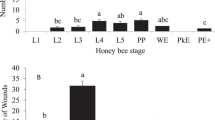Abstract
The damage to western honey bee, Apis mellifera, colonies caused by the originally Asian ectoparasitic mite Varroa destructor is mainly a consequence of the infestation of host bee pupae. In the capped brood cell, female mites puncture the host's integument at preferred sites in order to suck haemolymph. Due to repeated feeding by the mother mite and her progeny, these perforations are kept open until shortly before the imaginal moult of the bee. Thereafter scarring takes place, thus preventing microbial infection after the adult bee has emerged from the protected environment of the sealed brood cell. However, colonies of various bacteria were found in the open wounds of about 15–30% of all inspected host pupae with an abundance depended on the level of host brood cell infestation by the mite. The small punctures of the pupal integument are difficult to detect but, by vital staining with trypan blue, the wounds can be visualised. The ultrastructure of the pupal wounds, the bacterial colonies and the scarring process are documented by a series of scanning electron micrographs.




Similar content being viewed by others
References
Anderson DL, Trueman JWH (2000) Varroa jacobsoni (Acari: Varroidae) is more than one species. Exp Appl Acarol 24:165–189
Baker RA (1991) Development and life-history strategies in mussel mites (Hydrachnellae: Unionicolidae). In: Schuster R, Murphy PW (eds) The acari. Chapman and Hall, London, pp 65–73
Büchler R (1992) Population dynamics of honeybee colonies with regard to infestation level. Apidologie 23:377–379
Brødsgaard CJ, Ritter W, Hansen H, Brødsgaard HF (2000) Interactions among Varroa jacobsoni mites, acute paralysis virus, and Paenobacillus larvae larvae and their influence on mortality of larval honeybees in vitro. Apidologie 31:543–554
Casteels PC, Ampe F, Jacobs F, Vaek M, Tempst P (1989) Apidaecins: antibacterial peptides from honeybees. EMBO J 8:2387–2391
De Jong (1997) Varroa and other parasites of brood. In: Morse RA (ed) Pests, predators and diseases of honey bees, 3rd edn. , Al Root, Medina, pp. 231–279
Donzé G, Guerin P M (1994) Behavioral attributes and parental care of Varroa mites parasitizing honey bee brood. Behav Ecol Sociobiol 34:305–319
Fan X (2001) Apis dorsal gene structure, role in oogenesis and embryonic development, signal in the induction of an innate immune response. Doctoral thesis, University of Tübingen, Tübingen
Garrido C, Paxton R, Rosenkranz P (2001) Varroa-Reproduktion: Wirtsfaktoren oder Eigenschaften des Parasiten? Apidologie 32:481–482
Ifantidis MD (1988) Some aspects of the process of Varroa jacobsoni mite entrance into honeybee (Apis mellifera) brood cells. Apidologie 19:387–396
Ifantidis MD, Rosenkranz P (1988) Reproduktion der Bienenmilbe Varroa jacobsoni (Acarina: Varroidae). Entomol Gen 14:11–122
Kanbar G, Engels W, Winkelmann G (2002) Übertragen Varroa-Milben auch Faulbrut (Melissococcus pluton)? Apidologie (in press)
Koeniger N, Koeniger G (2000) Reproductive isolation among species of the genus Apis. Apidologie 31:313–339
Koeniger N, Koeniger G, Wijayagunasekara NHP (1981) Observations on the adaptation of Varroa jacobsoni to its natural host Apis cerana in Sri Lanka. Apidologie 12:37–40
Kovac H, Crailsheim K (1987) Varroa jacobsoni Oud. changes its host. In: Rembold H (ed) Chemistry and biology of social insects. J. Peperny, Munich, pp 681–682
Matheson A (1993) World bee health report. Bee World 74:176–212
Murilhas AM (2002) Varroa destructor infestation impact on Apis mellifera carnica capped worker brood production, bee population and honey storage in a Mediterranean climate. Apidologie 33:271–281
Rehm S-M, Ritter W (1989) Sequence of the sexes in the offspring of Varroa jacobsoni and the resulting consequences for the calculation of the developmental period. Apidologie 20:339–343
Ruttner F (1988) Biogeography and taxonomy of honeybees. Springer, Berlin Heidleberg New York
Smirnow AM (1978) Research results obtained in USSR concerning aetiology, pathogenesis, epizootiology, diagnosis and control of Varroa disease in bees. Apiacta 13:149–162
Steiner J, Dittmann F, Rosenkranz P, Engels W (1994) The first gonocycle of the parasitic mite (Varroa jacobsoni) in relation to preimaginal development of its host, the honey bee (Apis mellifera carnica). Invertebr Reprod Dev 25:175–183
Tewarson NC, Sing A, Engels W (1992) Reproduction of Varroa jacobsoni in colonies of Apis cerana indica under natural and experimental conditions. Apidologie 23:161–171
Wiegers FP (1988) Transmission of honeybee viruses by Varroa jacobsoni Oud. In: Cavalloro R (ed) European research on varroatosis control. Commission of the European Communities, Rotterdam, pp. 99–104
Acknowledgements
We would like to thank Dr. R. Paxton for critically reading of the manuscript, Imkermeister A. Oelkrug for rearing the bees and supplying many Varroa-infested drone combs and H. Schoppmann for excellent technical assistance in preparing the electron micrographs.
Author information
Authors and Affiliations
Corresponding author
Additional information
An erratum to this article is available at http://dx.doi.org/10.1007/s00436-003-0899-1.
Rights and permissions
About this article
Cite this article
Kanbar, G., Engels, W. Ultrastructure and bacterial infection of wounds in honey bee (Apis mellifera) pupae punctured by Varroa mites. Parasitol Res 90, 349–354 (2003). https://doi.org/10.1007/s00436-003-0827-4
Received:
Accepted:
Published:
Issue Date:
DOI: https://doi.org/10.1007/s00436-003-0827-4




